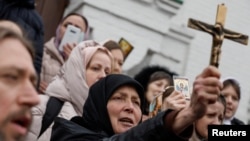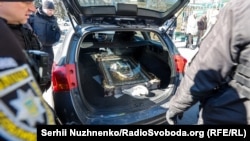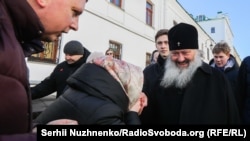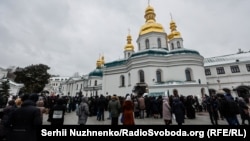Nearly 1,000 years ago, when Kyiv was the capital of a kingdom known as Kyivan Rus ruled by Prince Yaroslav the Wise, several Orthodox Christian monks were granted permission to build a church on a hilltop on the western bank of the Dnieper River.
Over time, the Kyiv-Pechersk Lavra grew to include more churches, residences for monks, and a labyrinth of subterranean caves and passages, dug deep into the hillside, with icons, crypts, and chapels filled with the incense of sweet-smelling beeswax from flickering candles.
“For centuries, the Kyiv-Pechersk Monastery, with relics of saints buried in caves, has been one of the most important Christian pilgrimage centers in the world,” the United Nations heritage organization UNESCO says. “A masterpiece of human creative genius in both its architectural conception and its remarkable decoration.”
The Monastery of the Caves, as it is also known in English, has been tangled up for years in worsening Ukrainian-Russian relations, relations that resulted in a formal split -- a schism -- between the Ukrainian and Russian Orthodox churches in 2019, when the Ukrainian church was granted independence.
Now the issue is coming to a head at the historic monastery, as Ukrainian officials demand that the priests who live there -- some of whom are suspected of recognizing the authority of the Moscow church -- vacate the facility.
On March 30, the clerics again defied eviction orders, refusing entry to both Culture Ministry officials and journalists, prompting scuffles.
Here’s what you need to know about the site and the fight.
Why Kyiv? And Why Caves?
Historical records say that in the year 988 or 989, a Kyivan prince named Volodymyr embraced the form of Christianity that was rapidly spreading out of Constantinople -- present-day Istanbul -- and was baptized, formally making it the kingdom’s official religion.
Less than a century later, Volodymyr’s grandson Iziaslav gave Orthodox priests Antony and Feodosiy permission to build the complex.
The monastery, and Kyiv itself, endured a siege by princes from what is today Russia, as well as pillaging by the Tatar-Mongol armies that swept across Asia and Eastern Europe in the 13th century and occupied much of the landmass for decades.
Beginning roughly in the 17th century, the complex was rebuilt and expanded, acquiring many of its Baroque architectural features.
Despite the official atheism of the Soviet Union, the monastery complex remained intact. The Nazi invasion in 1941 and the siege and occupation of Kyiv caused immense damage to the complex. The main Cathedral of the Assumption was destroyed.
After the Soviet collapse in 1991, Ukrainian officials worked to upgrade and modernize the facility. Scores of priests and monks live and work at the complex, and it’s now one of Kyiv’s most visited sites, both for regular tourists and for pilgrims.
Whose Church? Whose God?
The Russian Orthodox Church, the largest single unit among all Eastern Orthodox churches, has for centuries claimed the mantle of being the true home of Orthodox Christianity.
It has long held sway over one of the main branches of the splintered Orthodox faith in Ukraine, known until recently as the Ukrainian Orthodox Church-Moscow Patriarchate.
This hierarchy dates back to the 17th century when a group of bishops in Moscow, then the capital of the Russian Empire, effectively took control of the Ukrainian church.
In the chaotic years after the Bolshevik Revolution and the Russian Civil War, a rival church -- the Ukrainian Autocephalous Orthodox Church -- was established.
But it was marginalized by Soviet officials, even during periods when the Soviet Communist Party was quietly tolerant of some religious practice.
After the Soviet breakup, a church called the Ukrainian Orthodox Church-Kyiv Patriarchate emerged, competing for Orthodox primacy in the country. The monastery, however, remained under the control the Ukrainian Orthodox Church-Moscow Patriarchate.
As tensions built following the outbreak of a Russia-fueled conflict in the eastern Donbas region and Russia’s seizure of the Crimean Peninsula in 2014, the Ukraine churches edged further away from Moscow. In late 2018, the Ukrainian Autocephalous Orthodox Church and Ukrainian Orthodox Church-Kyiv Patriarchate essentially merged, creating the new Orthodox Church of Ukraine.
In January 2019, the spiritual head of all Orthodox Christians, Ecumenical Patriarch Bartholomew of Constantinople, recognized that church’s independence from Moscow.
The Russian Orthodox Church and its leader, Patriarch Kirill, were not pleased.
In May 2022, three months after Russia launched its full-scale invasion, the Ukrainian Orthodox Church-Moscow Patriarchate said it had renounced its ties to Moscow and the Russian Orthodox Church. It renamed itself the Ukrainian Orthodox Church -- a moniker Kyiv says it has no right to claim.
A 2020 survey found that 34 percent of Ukrainians identified as members of the Orthodox Church of Ukraine, while 14 percent said they were members of the Ukrainian Orthodox Church.
Confused Yet?
The Monastery of the Caves is formally controlled by the Orthodox Church of Ukraine -- the pro-Kyiv church -- but only partly. Some of the priests remaining there have been suspected of harboring allegiances to Moscow.
The symbolism of Orthodox priests with any sort of hint of allegiance to Moscow during wartime, living in a holy site like the monastery, is unacceptable for many Ukrainians.
There’s also the religious symbolism. The Monastery of the Caves draws pilgrims from around the world. The complex is home to dozens of bodies -- some centuries old -- of priests, some of whom have been beatified and made saints.
There’s also control of the tourist revenues, not all of which end up being shared with the Ukrainian government.
Around three dozen Orthodox priests around the country have been arrested by Ukrainian law enforcement since the February 2022 invasion, accused of unspecified acts of sabotage or of gathering intelligence and sending it to Moscow.
In November, Ukrainian security agents raided the Monastery of the Caves complex, searching for what they said were weapons or anti-Ukrainian propaganda. A Russian Orthodox Church spokesman called it an "act of intimidation" against Ukrainian believers.
Earlier this week, as the deadline for eviction neared, some priests could be seen packing up items and loading them into trucks. Photographs circulating on social media purported to show some hallways with icons missing from walls.
On the day of the formal deadline -- March 29 -- scores of believers attended mass at the monastery’s main cathedral. Some holdout priests refused to let Ukrainian cultural officials into some of the property’s buildings, resulting in some scuffles and pushing.
On March 31, another standoff occurred.
In Moscow, Kremlin spokesman Dmitry Peskov condemned the effort to evict the remaining priests. In Kyiv, meanwhile, Culture Minister Oleksandr Tkachenko told RFE/RL’s Ukrainian Service that he hoped that cooler heads would prevail.
“I hope that the [holdout priests] will come to their senses," he said.












